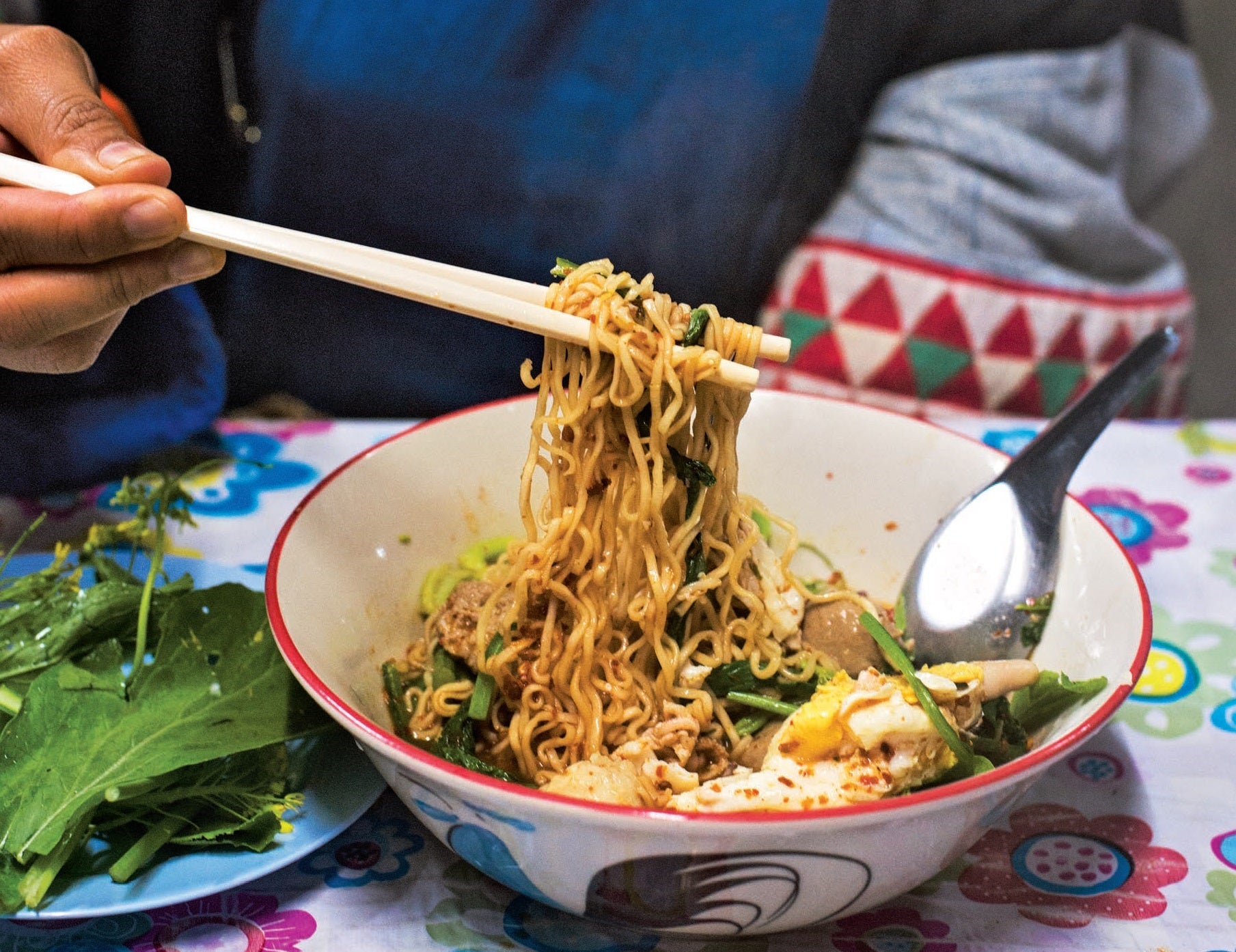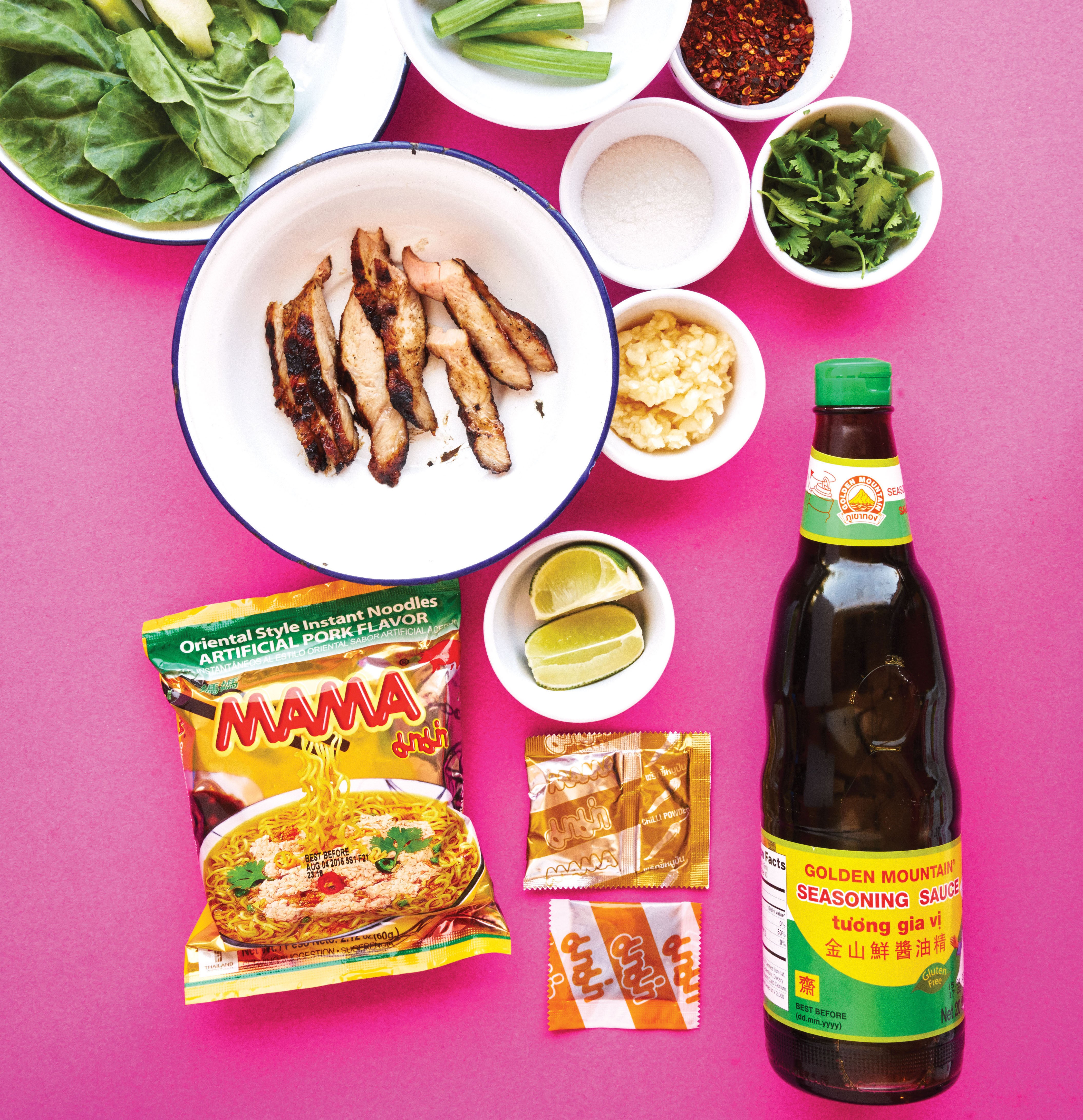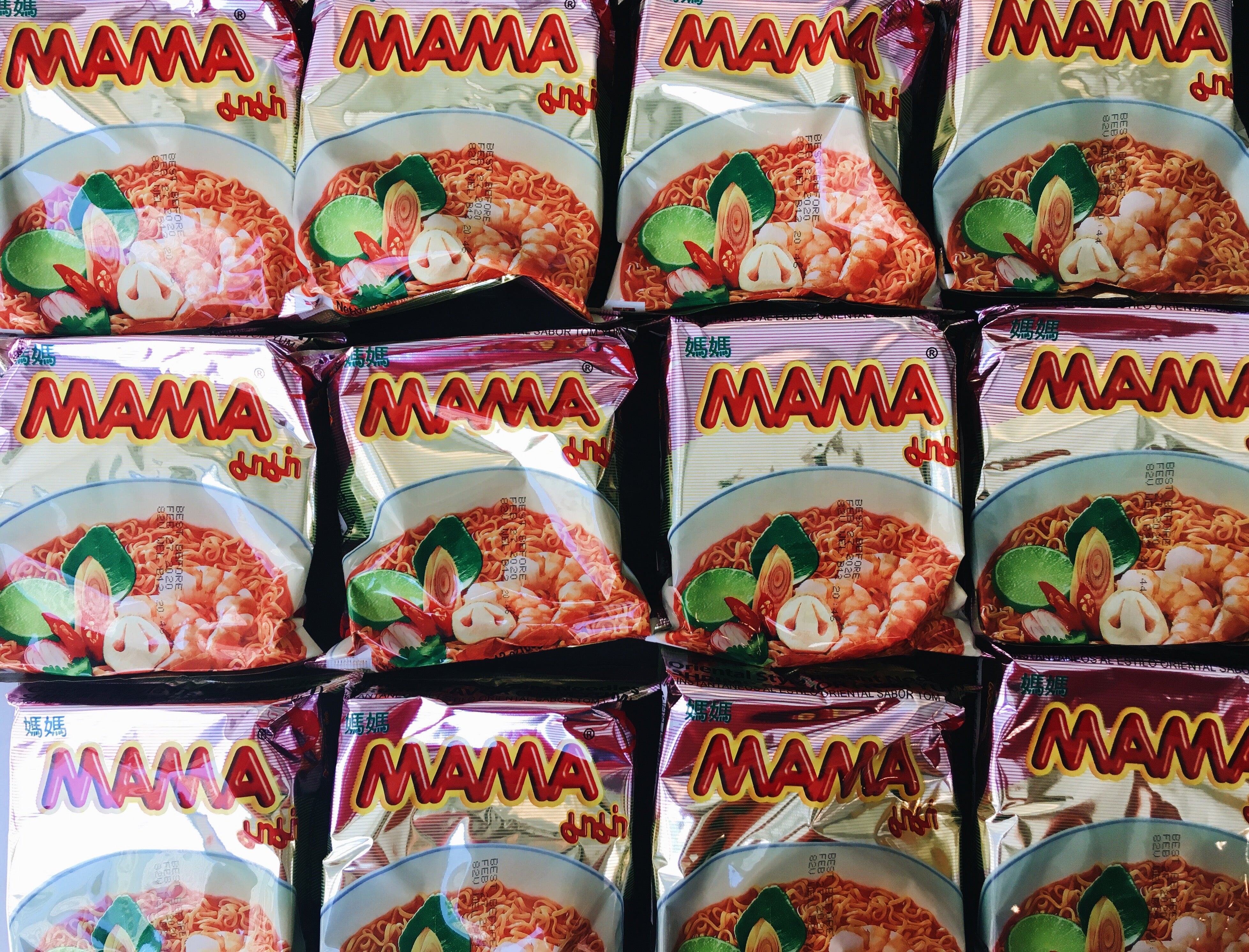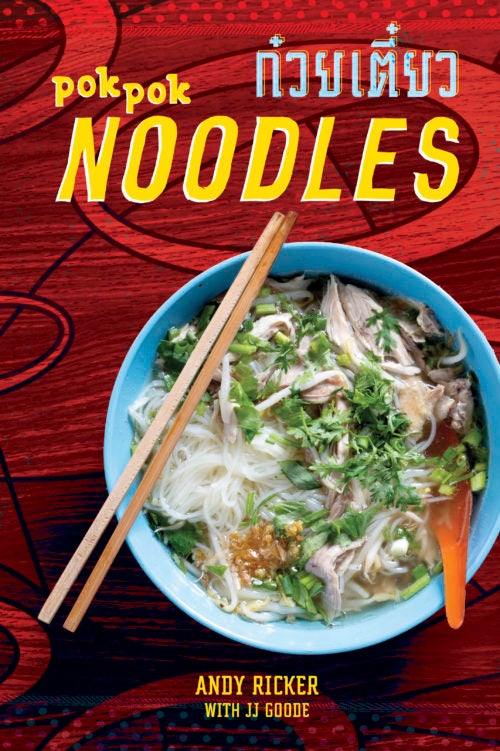Our recipes and stories, delivered.

There’s a reason the instant noodle brand is the star of so many noodle shops in Thailand.
In Thailand, the Mama brand of instant noodles is ubiquitous enough that people tend to refer to all instant noodles as “Mama”—the way some Americans refer to tissues as “Kleenex” or the British call vacuums the “Hoover.” The noodles pop up in stir-fries served in dining halls, soups purchased from noodle shops, and even as a crunchy, dry snack on their own.
As Kris Yenbamroong writes in his book, Night + Market, the brand is “so popular stir-fried that most people refer to it as its own dish, Mama pad.” His recipe pairs the stir-fried noodles with bacon, Chinese broccoli, and lots of cilantro.

The ingredients for Kris Yenbamroong’s stir-fried Mama noodles (photo by Marcus Nilsson)
Thai President Foods, the company that makes Mama noodles, owns 53 percent of the instant noodle market share in Thailand and sells more than $300 million in noodles every year. There are plenty of other popular brands, like Wai Wai and Yum Yum, but Mama is the country’s most famous, both in Thailand and internationally.
Of the 50 or so flavors of Mama noodles that Thai President Foods makes (pad kee mao, vegetarian shiitake, green curry, and chicken masala, to name a few), the tom yum is its most iconic—flavored with shrimp, fish sauce, lemongrass, and chile. “It’s by far the most popular in Thailand,” says chef Andy Ricker. “Spicy, a little sour, and a bit rich from the oil seasoning they put in it.”

The popular tom yum flavor of Mama noodles
In his latest book, Pok Pok Noodles, Ricker includes a recipe for a soup built around the flavor of tom yum. It pays tribute to one that Pa Riang makes at the restaurant Mama Fah Thani in Chiang Mai—a shop that exclusively serves Mama noodles. The salty, acidic flavor packet is punched up with some added tamarind and fish sauce, and some shrimp and pork stock add a little bit of richness. The bowl is crowned with a poached egg and a sprinkle of cilantro.
“Texturally speaking, it gets mushy if you don’t eat it quickly after it is cooked, much like fresh ramen,” says Ricker. “But I’m not sure that’s a disadvantage.”
Pok Pok Noodles has its own recipe for stir-fried Mama noodles, with pork, cabbage, and egg—a dish that Ricker describes as a “delicious fridge-cleaner.” Ricker also writes about yam Mama—a fresh salad of noodles, shrimp, tomatoes, fresh mint, and lots of lime juice and fish sauce.
My first exposure to Mama noodles was in college, when my roommate would bring them back after breaks by the suitcaseful from Delhi, where they were easier to find than in New York. (This was before we knew what Amazon Prime was.) Now I can buy them by the 30-pack, keep them around for emergencies (like a recent refrigerator outage), and turn them into off-the-cuff shrimpy soups and kitchen-sink stir-fries.
Lead photo by Austin Bush.

MAMA Naam: Spicy Instant Ramen Noodle Soup
1 bowl (1 serving); to make more, double or quadruple the ingredients, but make each bowl separately
Ingredients
- The Bowl
- 2 tablespoons Naam Makham Piak (Tamarind Water)
- 1 tablespoon Thai fish sauce
- 1 teaspoon Phrik Pon Khua (Toasted-Chile Powder)
- 1 teaspoon granulated sugar
- 1 package tom yam–flavored Thai instant ramen (such as MAMA brand), noodles, seasoning powder, and seasoning paste reserved
- The Dish
- 1 ½ cup Naam Sup Muu (Pork Stock)
- 1 egg, at room temperature
- 2 medium-size shrimp, peeled and deveined
- 4 Muu Sap Sawng Khreuang (Minced-Pork Balls)
- ½ cup roughly chopped (2 inches) yu choy (tender stems and leaves)
- 1 tablespoon very roughly chopped cilantro (thin stems and leaves)
- Accompaniments
- Roughly chopped (2 inches) yu choy (tender stems and leaves)
- Naam Phrik Makham (Tamarind-Chile Sauce)
- Naam Makham Piak (Tamarind Water)
- 3 tablespoons packed Vietnamese or Thai seedless tamarind pulp (also called tamarind paste)
- 1 ¾ cup water
- Phrik Pon Khua (Toasted-Chile Powder)
- 30 stemmed dried puya chiles
- Naam Sup Muu (Pork Stock)
- 5 pounds pork neck bones, cut by the butcher, if necessary, to fit in your pot
- 5 quarts water
- 1 unpeeled whole head garlic
- 1 ½ by 1-inch knob unpeeled ginger
- 8 cilantro roots, with several inches of stem attached, or 5 whole cilantro sprig
- 1 large stalk lemongrass (outer layer, bottom 1 inch, and top 9 inches removed), halved crosswise
- ½ small unpeeled daikon radish, halved lengthwise, then cut crosswise into about ¼-inch- thick slices
- 3 green onions, halved crosswise
- 3 leafy Chinese celery stalks, halved crosswise
- 1 teaspoon black peppercorns or Asian white peppercorns
- Muu Sap Sawng Khreuang (Minced-Pork Balls)
- 9 garlic cloves, peeled and halved lengthwise
- 12 ounces fatty ground pork
- 3 tablespoons fairly finely chopped cilantro (thin stems and leaves)
- 1 tablespoon Thai fish sauce
- ¾ tablespoons finely ground Asian white pepper
- Naam Phrik Makham (Tamarind-Chile Sauce)
- 2 tablespoons packed Vietnamese or Thai seedless tamarind pulp (also called tamarind paste)
- ½ cup hot water
- 3 tablespoons Phrik Pon Khua (Toasted Chile Powder)
- 1 tablespoon Thai fish sauce
- 1 tablespoon granulated sugar
At Mama Fah Thani, Pa Riang goes all in on instant noodles. Known as MAMA, after a brand that has come to refer to a product, instant noodles are an option at most shops selling noodle soup, and one of no less esteem than fresh wheat or rice noodles. At her restaurant, they’re all that’s on offer.
My recipe is an homage to her signature noodle soup. I took some guesses and I made some adjustments, like trading the dried squid (high-quality stuff is tough to find) for shrimp and poaching, rather than hammering, the eggs. But I try to stay true to its spirit. I don’t, for instance, ditch the envelopes of powdered flavoring. I add them to the broth just like she does. I certainly don’t upgrade to fresh rice noodles. MAMA might be a cheap, industrial product, but it’s welcome in my bowl anytime.
- In a medium saucepan, combine the tamarind pulp and the water and bring to a boil over high heat, breaking up the tamarind as it softens. Immediately turn off the heat, cover the pot, and let the mixture sit until the tamarind is very soft, about 30 minutes. There’s no need to skim off any foam. Set a medium-mesh strainer over a heatproof container.
- Use a whisk or wooden spoon to mash and stir the tamarind mixture, breaking up any large clumps. Pour the contents of the pan into the strainer, stirring, pressing, and smashing the solids to extract as much liquid as possible. There may be pulp clinging to the outside of the strainer; add that to the container, too. Discard the remaining solids. The tamarind water will keep in an airtight container in the fridge for up to 1 week and in the freezer for up to 3 months. Stir well before each use.
Naam Makham Piak (Tamarind Water)
Phrik Pon Khua (Toasted-Chile Powder)
- Put the chiles in a large, dry skillet or flat-bottomed wok, turn the heat to high to get the pan hot, and then turn the heat to low. Toast the chiles, stirring almost constantly and flipping them occasionally so all sides make contact with the hot pan, until they’re very brittle and very dark brown all over, 10 to 15 minutes. Remove the chiles from the pan as they are ready. Discard any seeds that escape from the chiles, as they will have burned and taste bitter.
- Let the chiles cool, then, working in batches if necessary, grind them in a burr grinder or pound in a mortar, to a coarse powder that is about halfway between cayenne powder and store-bought red pepper flakes. Immediately transfer to an airtight container. The powder will keep in a cool, dry place for several weeks.
Naam Sup Muu (Pork Stock)
- Put the bones in a large pot and add enough cold water to cover them by 1 inch or so. Cover the pot and bring the water to a simmer over high heat, then turn off the heat. Skim any scum from the surface, then drain the bones and rinse them well under cold running water. All this is to get any blood off the bones, which will give you a cleaner-tasting, clearer stock.
- Clean the pot, return the bones to the pot, and add enough of the 5 quarts water to cover by an inch or so. Bring the water to a bare simmer over high heat, lower the heat to maintain a bare simmer, and cook, skimming off any surface scum occasionally, until all of the flavor has been cooked out of the meat on the bones, about 2 ½ hours.
- Working with one ingredient at a time, use a pestle or heavy pan to lightly whack the garlic, ginger, cilantro roots, and lemongrass to bruise them. Very roughly slice the ginger and lemongrass. After the bones have simmered for 2 ½ hours, add the bruised aromatics to the pot along with the daikon, green onions, Chinese celery, and peppercorns. Simmer gently for 30 minutes more. Strain the stock into a large bowl or pot (don’t press the solids) and discard the solids. Use the stock now, or let it cool and then store in airtight containers in the fridge for up to 5 days or in the freezer for up to 6 months.
Muu Sap Sawng Khreuang (Minced-Pork Balls)
- Bring a large pot of water to a very gentle simmer and adjust the heat to maintain the simmer.
- Meanwhile, in a mortar, pound the garlic to a fairly smooth paste, 2 to 3 minutes. Working in batches, if necessary, add the pork, cilantro, fish sauce, and pepper and pound until the mixture is well combined and slightly sticky (remember, you’re not being gentle with the mixture as you would with Italian meatballs), about 1 minute.
- In three or four batches, and working one by one, make about 1-inch balls—grab about 14 g / 2 tsp of the mixture and quickly form a rough ball—and carefully drop them into the simmering water as you form them. Cook until they float and are just cooked through, 2 to 3 minutes. As they’re done, use a slotted spoon or spider to scoop them onto a plate in a single layer. Fully cooled, the balls will keep in an airtight container in the fridge for up to 1 week or in the freezer for up to 6 months.
Naam Phrik Makham (Tamarind-Chile Sauce)
- In a small mixing bowl, combine the tamarind pulp and hot water. Let the mixture sit until cool enough to handle, then use your hands to break up the softened tamarind pulp. Pour the mixture through a medium-mesh strainer into a bowl, stirring and pressing the solids to extract as much liquid as you can. Stir in the toasted-chile powder, fish sauce, and sugar until well combined. The sauce will keep in an airtight container in the fridge for up to 1 week.
Prep the Bowl
- In a wide soup bowl, combine the tamarind water, fish sauce, toasted-chile powder, and sugar. In a small bowl, combine the seasoning powder and seasoning paste from the instant ramen package, stir well, then add 3 g / 1 tsp of the mixture to the wide bowl, reserving the rest for other bowls of soup.
Make the Dish
- Fill a large, tall pot with enough water to submerge a long-handled noodle basket and bring to a boil over high heat.
- Meanwhile, pour the pork stock into a small pot and bring to a boil over high heat. Crack in the egg, lower the heat to maintain a gentle simmer, and poach the egg for 2 to 3 minutes, until cooked to your liking. Use a slotted spoon or spider to transfer the egg to a plate and set it aside. Keep the stock warm.
- Put the block of instant ramen noodles in the noodle basket (breaking the noodles slightly to fit if need be), then add the shrimp, minced-pork balls, and yu choy. Submerge the contents in the boiling water and cook, stirring occasionally with chopsticks to separate the noodles, until the shrimp are cooked and the noodles are tender, about 2 minutes. Firmly shake the basket to drain well and dump the contents into the prepared bowl.
- Pour on the hot stock and stir briefly but well. Add the poached egg and sprinkle on the cilantro. Serve with the accompaniments and khruang phrung alongside.
Ingredients
- 2 ½ ounces pork loin, cut into 2 by ½ by ⅛-inch strips
- 4 garlic cloves, peeled and crushed into small pieces in a mortar
- A few dashes of Thai seasoning sauce
- Dash of Thai fish sauce
- Pinch of finely ground Asian white pepper
- The Dish
- ½ cup roughly sliced (½-inch half-moons) napa cabbage
- ½ cup bean sprouts
- ¼ cup julienned (about 3 by ⅛ inch) peeled carrot
- ¼ cup thinly sliced (¼ inch; with the grain) yellow onion
- ¼ cup roughly chopped (2 inches) yu choy (stems and leaves)
- 1 package Thai instant ramen (such as MAMA brand), seasoning powder and seasoning paste discarded
- 1 tablespoon neutral oil, such as canola, soybean, or rice bran
- 1 egg, at room temperature
- ¼ cup Naam Sup Muu (Pork Stock)
- 1 tablespoon Thai seasoning sauce
- 1 tablespoon Thai oyster sauce
- 1 teaspoon granulated sugar
- Generous pinch of finely ground Asian white pepper
- 2 tablespoons sliced (¼ inch) green onion
- Naam Sup Muu (Pork Stock)
- 5 pounds pork neck bones, cut by the butcher, if necessary, to fit in your pot
- 5 quarts water
- 1 unpeeled whole head garlic
- 1 ½ by 1-inch knob unpeeled ginger
- 8 cilantro roots, with several inches of stem attached, or 5 whole cilantro sprig
- 1 large stalk lemongrass (outer layer, bottom 1 inch, and top 9 inches removed), halved crosswise
- ½ small unpeeled daikon radish, halved lengthwise, then cut crosswise into about ¼-inch- thick slices
- 3 green onions, halved crosswise
- 3 teaspoons leafy Chinese celery stalks, halved crosswise
- 1 teaspoon black peppercorns or Asian white peppercorns
I was meeting my friend Ajaan Sunee for lunch at Chiang Mai University when I first encountered this unassuming stir-fry. Ajaan Sunee, the college’s home ec professor at the time, took me to the school’s cafeteria, which students swarmed between classes. In particular, they crowded around a vendor renowned for her MAMA phat. The dish is typical college-kid fare—economical, simple, filling. It was a testament to this cook’s talent that she could inspire such enthusiasm for what is essentially a collection of the least expensive ingredients available—cabbage, carrot, onion, and briefly boiled instant noodles—tossed for a spell in a hot wok. Made with care, though, the dish transcends its status to become something I’d gladly eat any time.
Compared to most versions, this recipe calls for a goddamn panoply of vegetables, all of which count as suggestions that you can take or leave. One of the great things about MAMA phat is that it’s a delicious fridge-clearer. Virtually any vegetable is welcome. The pork, too, can be swapped at will for shrimp, chicken, or tofu. Just don’t get fancy with the noodles.
- Put the bones in a large pot and add enough cold water to cover them by 1 inch or so. Cover the pot and bring the water to a simmer over high heat, then turn off the heat. Skim any scum from the surface, then drain the bones and rinse them well under cold running water. All this is to get any blood off the bones, which will give you a cleaner-tasting, clearer stock.
- Clean the pot, return the bones to the pot, and add enough of the 5 quarts water to cover by an inch or so. Bring the water to a bare simmer over high heat, lower the heat to maintain a bare simmer, and cook, skimming off any surface scum occasionally, until all of the flavor has been cooked out of the meat on the bones, about 2 ½ hours.
- Working with one ingredient at a time, use a pestle or heavy pan to lightly whack the garlic, ginger, cilantro roots, and lemongrass to bruise them. Very roughly slice the ginger and lemongrass. After the bones have simmered for 2 ½ hours, add the bruised aromatics to the pot along with the daikon, green onions, Chinese celery, and peppercorns. Simmer gently for 30 minutes more. Strain the stock into a large bowl or pot (don’t press the solids) and discard the solids. Use the stock now, or let it cool and then store in airtight containers in the fridge for up to 5 days or in the freezer for up to 6 months.
Naam Sup Muu (Pork Stock)
Prep the Pork
- In a small bowl, combine the pork, garlic, seasoning sauce, fish sauce, and pepper. Mix well with your hands, then let marinate for 5 minutes or so.
Make the Dish
- In a small bowl, combine the cabbage, bean sprouts, carrot, onion, and yu choy and set aside.
- Fill a large, tall pot with enough water to submerge a long-handled noodle basket and bring to a boil over high heat. Put instant ramen noodles in the basket (breaking the noodles slightly to fit if need be) and submerge the noodles in the boiling water. Cook, stirring occasionally with chopsticks to separate, until the noodles are tender, about 2 minutes. Firmly shake the basket to drain well and set aside.
- Set a flat-bottomed wok over very high heat and heat until it begins to smoke lightly. Add the oil and swirl the wok to coat the sides. Add the pork mixture and stir-fry, constantly stirring, scooping, and flipping the ingredients, until the outsides of the pork are no longer raw, 5 to 10 seconds. Push to one side of the wok, then crack the egg onto the other side and cook until the white is nearly set, about 15 seconds. Flip the egg (it’s okay if the yolk breaks) and stir-fry, breaking up the egg slightly, until it’s just about fully cooked, about 10 seconds more.
- Add the noodles and cabbage mixture and stir-fry until the vegetables are wilted and just tender, about 45 seconds. Add the pork stock, seasoning sauce, and oyster sauce and stir well. Add the sugar and pepper, stir-fry for 10 seconds, and turn off the heat.
- Transfer to a plate and sprinkle with the green onion.
Ingredients
- 4 garlic cloves, peeled and halved lengthwise
- 4 stemmed fresh or frozen Thai chiles (preferably green)
- 2 tablespoons fresh lime juice (preferably from Key limes or from regular [Persian] limes with a squeeze of Meyer lemon juice)
- 2 tablespoons Thai fish sauce
- 2 tablespoons Naam Cheuam Naam Taan Piip (Palm Sugar Simple Syrup)
- 1 package Thai instant ramen (such as MAMA brand), seasoning powder and seasoning paste discarded
- 4 medium shrimp, peeled and deveined
- 2 ounces Vietnamese pork roll, halved lengthwise and cut crosswise into ⅛-inch- thick slices
- ¼ cup thinly sliced (¼ inch; with the grain) yellow onion
- 5 (1-inch) cored tomato wedges
- ¼ cup small mint leaves
- 2 tablespoons sliced (¼ inch) green onion
- 2 tablespoons very roughly chopped Chinese celery (thin stems and leaves)
- 1 tablespoon very roughly chopped cilantro (thin stems and leaves)
Instant noodles wind up practically everywhere regular noodles do, and even occasionally where they don’t. For instance, I’ve seen people crunch into them straight from the bag. It’s no shocker, then, that the beloved product—called MAMA in Thai, in reference to the best-known brand—makes great fodder for yam. Yam is often translated as “salad,” and while the English word does the trick, it doesn’t do much justice in describing the room-temperature jumbles of vegetables, herbs, and proteins dressed with lime juice, fish sauce, and chiles. When MAMA enters the fray, yam becomes a hearty snack to share while you booze, the heat and salt compelling another swig, and then another.
- Fill a large, tall pot with enough water to submerge a long-handled noodle basket and bring to a boil over high heat. Meanwhile, pound the garlic and chiles in a mortar to a very coarse paste, about 1 minute. Transfer 12 g / 1 tbsp of the mixture (or more to taste) to a medium saucepan, add the lime juice, fish sauce, and palm sugar simple syrup and stir well.
- When the water comes to a boil, put the instant ramen, shrimp, and pork roll in the noodle basket and submerge the contents in the boiling water. Cook, stirring occasionally with chopsticks to separate the noodles, until the shrimp are cooked and the noodles are fully tender (not al dente), about 2 minutes. Firmly shake the basket to drain well and set aside.
- Set the saucepan with the garlic-chile mixture over medium heat and heat until the mixture is just warm to the touch, 15 seconds or so. Turn off the heat and add the noodles, shrimp, and pork roll to the saucepan, then the yellow onion, tomato, mint, green onion, Chinese celery, and cilantro. Toss well and transfer the salad (including all of the dressing) to a plate in a low heap. Serve right away.


